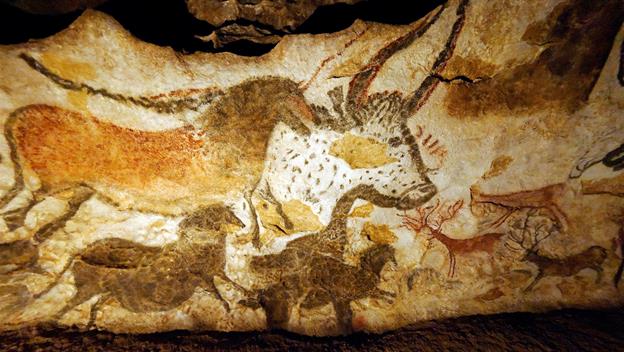1940
Near Montignac, France, a collection of prehistoric cave
paintings are discovered by four teenagers who stumbled upon the ancient
artwork after following their dog down a narrow entrance into a cavern.
The 15,000- to 17,000-year-old paintings, consisting mostly of animal
representations, are among the finest examples of art from the Upper
Paleolithic period.
First studied by the French archaeologist Henri-Édouard-Prosper Breuil, the Lascaux grotto consists of a main cavern 66 feet wide and 16 feet high. The walls of the cavern are decorated with some 600 painted and drawn animals and symbols and nearly 1,500 engravings. The pictures depict in excellent detail numerous types of animals, including horses, red deer, stags, bovines, felines, and what appear to be mythical creatures. There is only one human figure depicted in the cave: a bird-headed man with an erect phallus. Archaeologists believe that the cave was used over a long period of time as a center for hunting and religious rites.
The Lascaux grotto was opened to the public in 1948 but was closed in 1963 because artificial lights had faded the vivid colors of the paintings and caused algae to grow over some of them. A replica of the Lascaux cave was opened nearby in 1983 and receives tens of thousands of visitors annually.

Lascaux cave paintings discovered
First studied by the French archaeologist Henri-Édouard-Prosper Breuil, the Lascaux grotto consists of a main cavern 66 feet wide and 16 feet high. The walls of the cavern are decorated with some 600 painted and drawn animals and symbols and nearly 1,500 engravings. The pictures depict in excellent detail numerous types of animals, including horses, red deer, stags, bovines, felines, and what appear to be mythical creatures. There is only one human figure depicted in the cave: a bird-headed man with an erect phallus. Archaeologists believe that the cave was used over a long period of time as a center for hunting and religious rites.
The Lascaux grotto was opened to the public in 1948 but was closed in 1963 because artificial lights had faded the vivid colors of the paintings and caused algae to grow over some of them. A replica of the Lascaux cave was opened nearby in 1983 and receives tens of thousands of visitors annually.


No comments:
Post a Comment